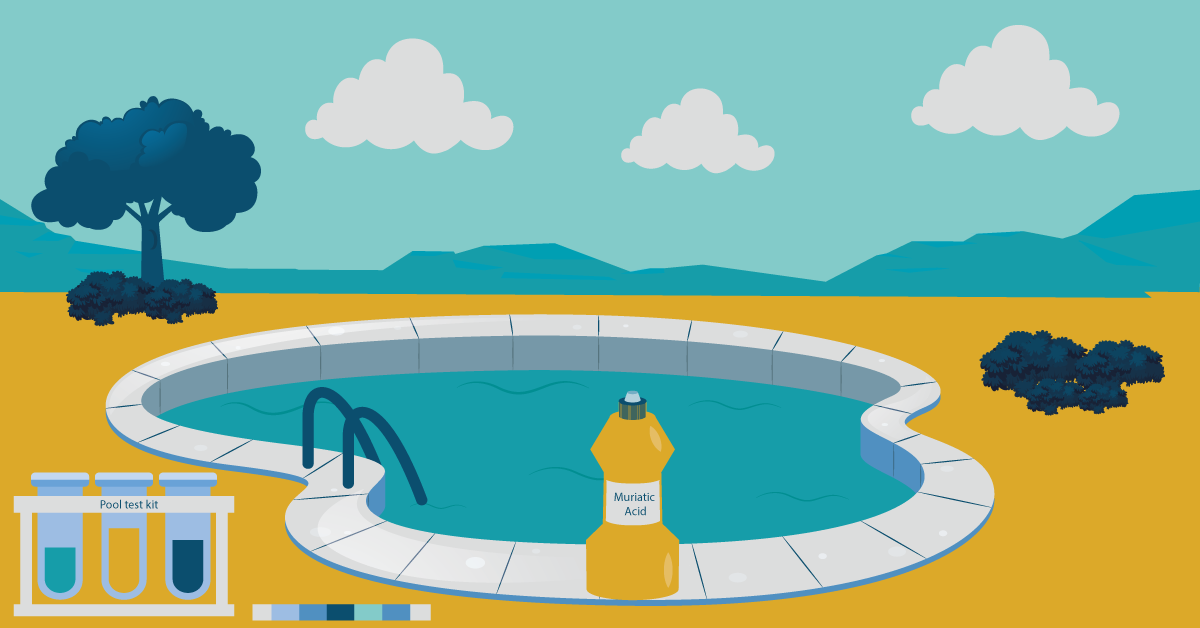When you own a swimming pool, especially a busy bigger inground pool you’ll run into balancing problems that have to do with alkalinity, pH, and chlorine residuals that over time can sneak up on you and the operation of your pool this causes downtime and costs. How do you fix low pH and high alkalinity?
- Recirculate pool with filter pump
- Calculate acid addition
- Add Muriatic acid diluted in a bucket of H2O & broadcast the acid around the pool
- Retest after 6-8 hours
- Once TA is 80-120 ppm
- Aerate the pool with a compressor or pump to mix the contents adding air
- Do this for 24-48 hrs.
- Retest pH and Alkalinity
When alkalinity or pH levels are too low, or too high, chlorine won’t work efficiently which means that your pool will remain dirty and things will continue to get worse until both controls are balanced. Read this article on these different scenarios that you may see.
Alkalinity and pH Relationship
You would think that low pH and low alkalinity or high alkalinity and high pH as a general rule are related but after 30 years of owning an inground pool, I can promise you they’re not. The pH and total alkalinity are independent of each other but both need to work together for balance.
It’s critical that you understand pool testing and use a dependable test kit and fresh reagents (that have expiration dates stamped on the bottles) before the season starts and before you begin Testing Pool Water.
The most important test to run on any type of swimming pool is Total Alkalinity. It’s key for keeping the water in your pool chemically balanced which will lead to lower chemical costs and lower filtering time besides the time saved for you as an operator.
Mastering your pool means taking some of the mystery out of it. One of the most mysterious sciences that pool owners deal with is the relationship between pH and Total Alkalinity and once you get that down then everything will make sense.
- pH is a measurement of acid concentration using the scale 0-14 pH with 7.0 being neutral-0 being acid and 14 being basic or alkaline not to be confused with alkalinity
- Alkalinity is the ability to bind, buffer, and neutralize the acid in a solution measured in parts per million (ppm)
- Alkalinity control keeps pH in check and resistant to changes that can move pH to the acidic side or the alkaline side of the scale.
Total Alkalinity (TA) control (80-120 ppm) keeps pH from rising or falling by neutralizing acids. Total alkalinity is a measure of how strongly your pool water can resist changes to pH which can affect the sanitation of pool water. TA works hand in hand with pH and chlorine.
Low pH and High Alkalinity
Adding acids to reduce total alkalinity will lower the pH. To lower total alkalinity without lowering pH, you will need to follow a two-step process.
- Keep the pool pump running bypassing the filter
- Add Muriatic acid- forget about the pH for now-Acid should be diluted in water (such as in a bucket) before you pour, it, and you broadcast the acid around the pool instead of pouring it all in one place. This will work faster
- Retest after 6-8 hours
- Once the alkalinity is correct TA 80-120 ppm– you need to raise your pH
- This can be done by simply aerating the pool. When you aerate a pool, you expose it to oxygen. This removes carbonic acid, thereby raising the pH level. You can also increase the rate of aeration with an air compressor or a wet vac with the hose in the opposite discharge port.
- I turn the outlets in the pool facing up which will mix the pool while the pool pump is running, this can help some. The key is to give your pool water as much surface area as possible. Point the pump returns up toward the surface of the water and turn on your pump at full blast. This will disturb the surface of the water, mixing it up and picking up air from the surface.
- Do this for 24-48 hours
- Retest pH and Alkalinity
What Causes Low Alkalinity in Pools?
- Rain can be acidic
- Increase in swimmer load
- Topping your pool off with H2O that has low alkalinity-after backwashing/wasting
- Chlorine-Chlorine is acidic
- High H2O evaporation-losing H2O can dilute TA
- Pool H2O agitation-H2O agitation increases the loss of CO2 …………………………………………………..Read more
How do you fix High pH with Low Alkalinity?
Put pool filter on recirculate
Run pump
Add soda Ash or sodium bicarbonate to raise alkalinity
Evenly distribute powder on the pool’s surface by walking around the pool
Waiting at least 6-8 hours for retesting TA
Once the alkalinity reading is 80-120 ppm .…………………………………………………………………. Read more
*Remember waiting for your swimming pool to turnover and the chemistry to change might be the hardest part of this discipline but until Total Alkalinity(TA) is balanced then your pool is not and pH won’t stay where it needs to be affecting Chlorine disinfection.
How do you adjust High pH with High Alkalinity?
- Run pool pump-bypass filter
- Test Total Alkalinity
- Calculate Muriatic Acid addition with a Pool Alkalinity Calculator
- Mix Muriatic Acid in a bucket of pool H2O
- Evenly distribute by walking around the perimeter of the pool
- Wait for 6-8 hrs
- If TA is 80-130 ppm .…………………………………………………………………………….. Read more
JimGalloway Author/Editor

